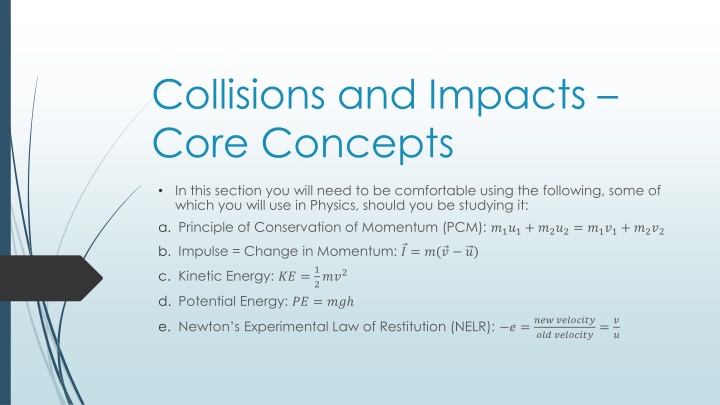
Core Concepts of Collisions and Impacts in Physics
Gain a solid understanding of key concepts like Principle of Conservation of Momentum, Impulse, Kinetic Energy, Potential Energy, and Newton's Experimental Law of Restitution. Dive into insightful examples illustrating these concepts in action, helping you comprehend the dynamics of collisions and impacts with ease.
Download Presentation

Please find below an Image/Link to download the presentation.
The content on the website is provided AS IS for your information and personal use only. It may not be sold, licensed, or shared on other websites without obtaining consent from the author. If you encounter any issues during the download, it is possible that the publisher has removed the file from their server.
You are allowed to download the files provided on this website for personal or commercial use, subject to the condition that they are used lawfully. All files are the property of their respective owners.
The content on the website is provided AS IS for your information and personal use only. It may not be sold, licensed, or shared on other websites without obtaining consent from the author.
E N D
Presentation Transcript
Collisions and Impacts Core Concepts In this section you will need to be comfortable using the following, some of which you will use in Physics, should you be studying it: a. Principle of Conservation of Momentum (PCM): ?1?1+ ?2?2= ?1?1+ ?2?2 b. Impulse = Change in Momentum: ? = ?( ? ?) c. Kinetic Energy: ?? =1 2??2 d. Potential Energy: ?? = ?? e. Newton s Experimental Law of Restitution (NELR): ? =??? ???????? ? ? ??? ????????=
Worked Example 1 A particle of mass 4 kg, moving with constant speed of 8 m/s, collides with a second particle of mass 3 kg, moving in the same straight line but towards the opposite direction with a speed of 4 m/s. After the collision the 4 kg particle moves with a speed of 2 m/s in the same direction as before the collision. Find: i. The speed of the 3 kg particle after the collision. ii. The loss in kinetic energy during the collision. iii. The impulse imparted to each particle. Note that the particles are moving in opposite directions before the collision. This means one of their speeds should be positive and the other negative. Taking PCM: ?1?1+ ?2?2= ?1?1+ ?2?2we get: 4 8 + 3 4 = 4 2 + 3(?2) 32 12 = 8 + 3?2 12 = 3?2 4 m/s = ?2
The loss in kinetic energy can be calculated by: ??????= ???????? ??????? 1 24 82+1 23 42 [1 24 22+1 23 42] ??????= ??????= 32 + 24 [8 + 24] ??????= 56 32 ??????= 24 ? Impulse is defined as the change in momentum, given by: ? = ?( ? ?) 4 kg particle ? = 4 2 8 3kg particle ? = 3(4 4 ) ? = 24 ?? ?/? ? = 24 ?? ?/? We should note the magnitude of the impulses are the same, but in opposite directions.
Worked Example 2 A ball is dropped from a height of 10 m onto a horizontal floor. Immediately after impact, the speed of the ball is 7 m/s. Find: i. The co-efficient of restitution between the ball and the floor. ii. How high the ball bounces. In order to use NELR, we need to know the speed of the ball as it lands on the floor. We can find this by taking the formula ?2= ?2+ 2??, as we know the initial speed of the ball is 0 (as the ball is dropped ) and the distance travelled is 10 m. ?2= (0)2+2?(10) ?2= 20? ? = 20? ? = 14 m/s
We can now apply NELR to find ?, the co-efficient of restitution: ? =??? ???????? ? Note we previously calculated the speed of the ball as it landed on the floor. As a velocity, this is negative as it is a downward speed. Hence, we will use -14 when filling into the formula: 7 14 ? = 1 2 ? =1 ??? ????????=? ? = 2 there are no units for ?. How high the ball bounces can be considered to be a maximum height question, and should be approached as we did in the Projectiles section taking ? = 0 at the maximum height. ?2= ?2+ 2?? (0)2= (7)2 2?? 2?? = 49 49 2? ? = 2 5 m ? =
